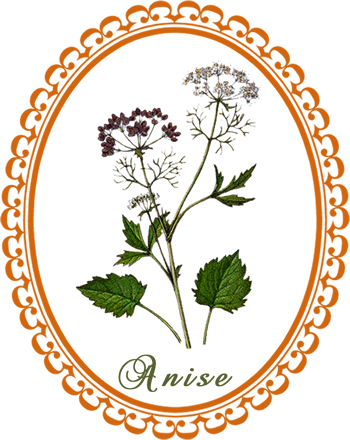
Anise: is an essential flavoring agent in many European liqueurs, most notably Pernod and ouzo ...
Common Names: Anise, Aniseed
Botanical Name: Pimpinella anisum
Family: Umbelliferae / Apiaceae
Plant Type: Annual
Parts Used: Seeds and leaves
Flowering: Summer
Anise is a flowering plant in the family Apiaceae native to the eastern Mediterranean region and Southwest Asia. It is known for its flavor, which resembles liquorice, fennel and tarragon.
Description: Anise is an herbaceous annual plant growing to 3 ft (0.91 m) tall. The leaves at the base of the plant are simple, 0.5–2 in (1.3–5.1 cm) long and shallowly lobed, while leaves higher on the stems are feathery pinnate, divided into numerous leaves. The flowers are white, approximately 3 mm diameter, produced in dense umbels. The fruit is an oblong dry schizocarp, 3 – 5 mm long. It is these seedpods that are referred to as "aniseed".
Cultivation: Anise plants grow best in light, fertile, well drained soil with a pH of 6.0. The seeds should be planted as soon as the ground warms up in spring. Because the plants have a taproot, they do not transplant well after being established, so they should be started either in their final location or transplanted while the seedlings are still small.
Harvesting: The stems are cut in August; the seeds are threshed out about a week later, when they have fully ripened.
Culinary Uses: Anise seeds have a very strong licorice flavor. It is used frequently in Greek, Scandinavian, East Indian, Moroccan and Arabic cuisines. Use the seeds in pastries, cakes, and cookies; they mix well with cinnamon and bay. Chop the leaves and use fresh in salads or as a garnish. Many liqueurs are flavored with anise.
Anise Magick
Youth. Protection. Purification.
Gender: Masculine
Planet: Jupiter
Element: Air
Use anise seeds to call forth spirits to aid your magick.
Hang a sprig of anise on your bedpost to restore lost youth.
Use anise seed in protection baths, combined with bay leaves.
Sleep on a small pillow of anise seeds to drive away nightmares.
Burn Anise as incense when you are seeking guidance from the gods.
To enhance your love life and attract abundance, place some anise seeds in your wallet.
Place anise seeds around your circle when practicing magic to protect you from evil spirits.
Herbal Healing with Anise
Medicinal Actions: Abortifacient, analgesic, antiemetic, antiseptic, antispasmodic, aperitive, aphrodisiac, calmative, cardic, carminative, digestive, disinfectant, diuretic (mild), estrogenic, expectorant, galactagogue, hepatic, insecticide, laxative, parasiticide, pectoral, stimulant (circulatory and digestive systems; respiratory tract), stomachic, tonic, warming
Medicinal Uses: The seeds can be chewed to freshen the breath. Anise tea is used as a digestive aid. Anise can be used to make an antimicrobial expectorant. Anise oil used externally can help control scabies and lice.
To treat digestive problems and coughs:
Infusion: Put 0.5-1 g seeds into a cup of boiling water. Drink two or three times a day after meals.
Tincture: (1:4 in 45% alcohol) Take 5-10 drops, three times a day in a little cold water after meals.
Powder: Take 3g a day in food.
To treat colic - Decoction: Boil 1 dessertspoon of seeds in 250ml of milk for 10 minutes and strain. Drink two or three times a day after meals.
Contraindications:
- No toxic effects have been reported to date.
- Do not take iron supplements when taking anise.
- Do not use when pregnant or breastfeeding.
- Do not sunbathe when taking anise as it may trigger sensitization to sunlight.
- High doses of essential oil may cause nausea and vomiting.
- Avoid creams if you have an inflammatory skin condition or if you experience any allergic reaction.
Healing Combinations with Anise
- Combine anise with fennel (Foeniculum) and caraway (Carum) as a good antiflatulence and anticolic remedy
- Combine anise with thyme (Thymus), licorice (Glycyrrhiza) and echinacea (Echinacea) for bronchitis and irritable coughs
- Combine anise with German chamomile (Matricaria), limeflower (Tilia), OR catnip (Nepeta) to help an excitable child go to sleep
Source: The Herb Handbook by Su Bristow
If you appreciate the information provided,
please help keep this website running. Blessings!
© 2008-2025 aromaworx.ca. All rights reserved.

